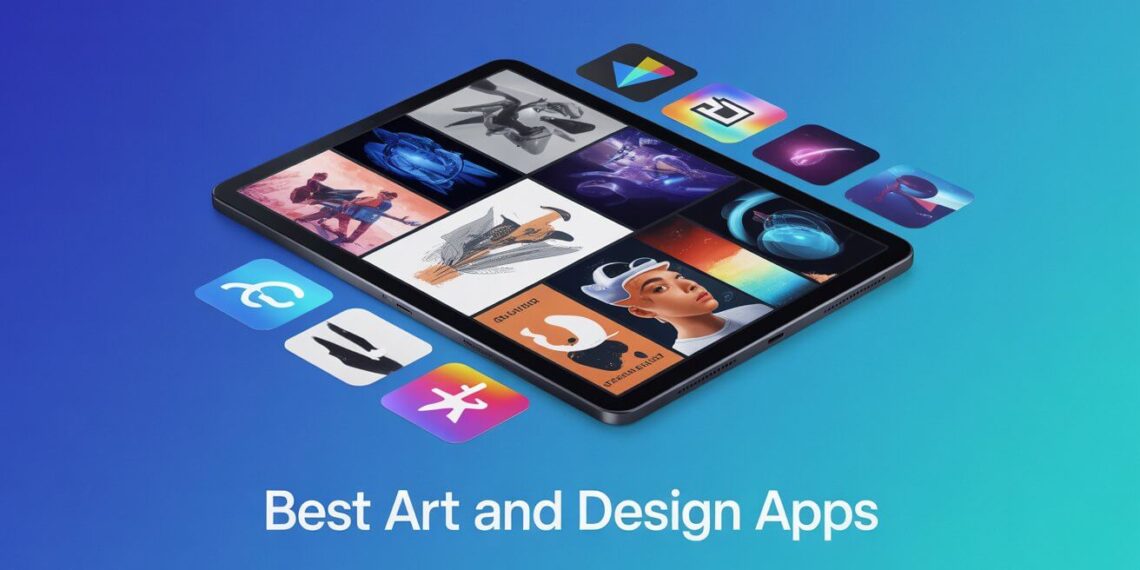Whether you’re a professional illustrator, a graphic design student, or just love doodling on your tablet, finding the right creative tools is essential. With mobile and desktop apps becoming more powerful than ever, artists now have access to studio-quality software right in their pocket.
In this guide, we’ve rounded up the best art and design apps across multiple categories: digital painting, graphic design, vector art, 3D modeling, UX/UI, and more. Whether you’re looking for free art apps for beginners or pro-grade tools for complex projects, there’s something here for every skill level and style.
Best Apps for Digital Painting & Illustration
These apps are designed to mimic traditional drawing and painting techniques while giving you the flexibility and versatility of digital tools.
Platform: iPad (with Apple Pencil support)
Pricing: One-time purchase approximately $12.99
Overview:
Procreate is a powerful and beloved drawing and painting app tailored specifically for iPad users. Designed with professional artists in mind, it features a sleek interface, intuitive gesture controls, and a brush engine that feels incredibly natural. With no subscription and a wide range of tools, it’s perfect for illustrators, concept artists, and hobbyists alike.
Key Features:
-
Over 200 customizable brushes, plus the ability to import or create your own
-
Full layering system with blend modes and masking
-
High-resolution canvas support (up to 16k x 4k on iPad Pro)
-
Time-lapse video recording of your artwork
-
ColorDrop for quick filling, quick shape for perfect geometry
-
Animation Assist for simple frame-by-frame animation
-
Export to PSD, PNG, JPG, or native Procreate formats
Best For:
-
Digital painting
-
Illustration and character design
-
Concept art
-
Sketching on-the-go
-
Artists who prefer a one-time purchase model
Pros:
-
Seamless Apple Pencil integration with pressure, tilt, and precision
-
No subscription required
-
Fast, smooth performance
-
Great for both beginners and professionals
-
Active community with free brushes and tutorials
Cons:
-
iOS-only (no Android or desktop support)
-
Limited vector or graphic design tools
-
No built-in cloud sync (you need iCloud or third-party storage)
2. Clip Studio Paint (iOS, Android, Windows, macOS)
Pricing: Subscription (monthly/yearly) or one-time license for desktop
Overview:
Clip Studio Paint is a favorite among comic creators, manga artists, and illustrators who want both powerful brush tools and specialized comic creation features. It has a steeper learning curve than some apps but rewards users with deep customization and control.
Key Features:
-
Advanced brush engine with realistic textures
-
Comic panel and speech bubble tools
-
3D model support for drawing assistance
-
Perspective rulers and symmetry tools
-
Timeline animation tools
-
Cloud syncing between devices
Best For:
-
Manga and comic book creation
-
Professional illustration
-
Artists transitioning from traditional to digital workflows
Pros:
-
Industry-standard for comic and manga artists
-
Works across devices with cloud backup
-
In-depth brush customization
Cons:
-
Subscription required for mobile versions
-
Interface can feel complex for beginners
3. Adobe Fresco (iOS, Windows)
Pricing: Free with in-app purchases; included in Creative Cloud bundles
Overview:
Adobe Fresco is Adobe’s answer to digital painting, combining both raster and vector brushes in one place. It’s particularly known for its live brushes, which simulate watercolor and oil painting with realistic blending.
Key Features:
-
Live watercolor and oil brushes that bleed and blend naturally
-
Integration with Adobe Photoshop and Illustrator
-
Vector brush support for scalable artwork
-
Unlimited layers and masking tools
-
Time-lapse video export
Best For:
-
Artists who use other Adobe products
-
Painters who want natural media simulation
-
Mixed-media and experimental workflows
Pros:
-
Seamless Adobe ecosystem integration
-
Unique live brushes mimic real paint
-
Free tier available
Cons:
-
Requires a Creative Cloud account for full features
-
Fewer brush customization options than Procreate or Clip Studio
Top Graphic Design Apps
Ideal for layout design, content creation, branding materials, and social media graphics.
4. Canva (iOS, Android, Web/Desktop)
Pricing: Free with premium Pro plan ($12.99/month or $119.99/year)
Overview:
Canva is one of the most popular design apps for non-designers and professionals alike. With its drag-and-drop interface and thousands of templates, it’s ideal for creating everything from social media graphics to business presentations and marketing materials. It’s user-friendly and doesn’t require prior design experience.
Key Features:
-
Access to millions of templates, icons, fonts, and stock photos
-
Easy-to-use interface with drag-and-drop functionality
-
Real-time collaboration and commenting
-
Brand Kit (with Pro plan) for consistent visual identity
-
Pre-sized templates for Instagram posts, YouTube thumbnails, resumes, flyers, etc.
-
Video editing and animation tools
Best For:
-
Social media managers
-
Small business owners
-
Bloggers and marketers
-
Educators and students
Pros:
-
Extremely beginner-friendly
-
Massive template and asset library
-
Free version includes generous features
-
Works on all devices
Cons:
-
Limited advanced customization
-
Less suitable for detailed professional-level design
-
Requires internet connection for most features
5. Affinity Designer (iOS, macOS, Windows)
Pricing: One-time purchase approx. $19.99 for iPad, $69.99 for desktop
Overview:
Affinity Designer is a professional vector and raster design tool often compared to Adobe Illustrator. It offers powerful tools for logo creation, UI/UX design, branding, and more without the need for a subscription. It’s well-optimized for iPad, making it one of the best portable design apps for professionals.
Key Features:
-
Precise vector and pixel editing in one app
-
Unlimited artboards and zoom at over 1 million percent
-
Advanced typography controls and grid systems
-
Real-time effects, blend modes, and layer styles
-
Snap-to-pixel accuracy for clean web and interface design
Best For:
-
Professional graphic designers
-
Logo and branding work
-
Web and UI mockups
-
Designers looking to avoid subscriptions
Pros:
-
Fully professional tool with great performance
-
No subscription pay once and own it
-
Cross-platform with iPad and desktop versions
-
Can handle complex projects with ease
Cons:
-
Steeper learning curve for beginners
-
Smaller template library compared to Canva
-
No cloud sync unless manually configured
Best Vector Drawing & Logo Design Tools
6. Adobe Illustrator (iPad, macOS, Windows)
Pricing: Subscription only ($20.99/month or included with Adobe Creative Cloud)
Overview:
Adobe Illustrator is the industry standard for vector design and logo creation. Now also available on iPad, it offers nearly the same functionality as the desktop version, including pen tools, vector brushes, and advanced path editing.
Key Features:
-
Precision vector drawing tools
-
Shape building, typography tools, and artboard management
-
Full Creative Cloud integration
-
Access to Adobe Fonts and Libraries
-
Real-time syncing between devices
Best For:
-
Professional logo designers
-
Print and web designers
-
Vector illustration work
Pros:
-
Industry gold standard with extensive features
-
Cross-device syncing and Adobe ecosystem
-
Highly precise tools for complex designs
Cons:
-
Subscription required
-
Can be overwhelming for beginners
-
May feel heavy on older devices
7. Vectornator (iOS, macOS)
Pricing: Free
Overview:
Vectornator is a free and surprisingly robust vector illustration app available for iPad, iPhone, and Mac. It’s well-suited for users who want to create professional-level designs without the cost of premium software.
Key Features:
-
Pen tool, shape builder, auto-trace, and Boolean operations
-
Unlimited layers, advanced text editing, and artboards
-
SVG and PDF import/export
-
Works seamlessly with Apple Pencil
-
Cloud sync with iCloud
Best For:
-
Freelancers and students
-
Mobile vector art
-
Logo design, typography, and layout
Pros:
-
Completely free with no ads
-
Powerful vector tools rivaling paid apps
-
Great for touch and pen input
-
Clean interface and good performance
Cons:
-
No Android or Windows support
-
Some advanced Illustrator features are missing
8. Inkscape (Windows, macOS, Linux)
Pricing: Free (Open-source)
Overview:
Inkscape is a fully-featured vector editor favored by those who want professional tools without the cost. It’s open-source, which means it’s constantly evolving and has a passionate community behind it.
Key Features:
-
Comprehensive vector drawing tools
-
Node editing, path operations, and bitmap tracing
-
Supports SVG, PDF, EPS, and AI formats
-
Customizable interface and extensions support
Best For:
-
Students
-
Budget-conscious designers
-
Cross-platform use including Linux
Pros:
-
100% free and open-source
-
Extensive feature set for a free program
-
Works well for creating logos, illustrations, and diagrams
Cons:
-
UI feels outdated compared to modern apps
-
Performance can lag with large files
-
Learning curve can be steep
Top 3D Art & Modeling Apps
If you’re venturing into 3D art, animation, or product design, these apps provide robust features for modeling, sculpting, and rendering.
9. Blender (Windows, macOS, Linux)
Pricing: Free (Open-source)
Overview:
Blender is a powerful, all-in-one 3D creation suite used for modeling, sculpting, animation, VFX, and rendering. It’s widely adopted in professional game development, animation studios, and indie filmmaking. Despite being free, it offers features that rival expensive 3D software.
Key Features:
-
Polygonal modeling, sculpting, texturing, and UV mapping
-
Powerful Cycles and Eevee rendering engines
-
Rigging, skinning, and pose animation
-
Node-based materials and compositing
-
Physics simulations (fluid, cloth, smoke)
-
Video editing and motion tracking
Best For:
-
Professional and aspiring 3D artists
-
Animators and game developers
-
Indie filmmakers and VFX creators
Pros:
-
Entirely free and open-source
-
Huge user community and thousands of tutorials
-
Regular updates and plugin support
-
Production-ready feature set
Cons:
-
Steep learning curve for beginners
-
Requires a powerful computer for rendering
-
Complex interface may feel overwhelming
10. Nomad Sculpt (iOS, Android)
Pricing: Approx. $14.99 one-time purchase
Overview:
Nomad Sculpt is a highly intuitive and tactile 3D sculpting app designed for mobile devices. It brings the feel of clay modeling into the digital world, optimized for stylus use like the Apple Pencil. Perfect for hobbyists and concept artists who want to sculpt on the go.
Key Features:
-
Dynamic topology and voxel remeshing
-
Clay, move, trim, and flatten tools
-
Real-time rendering with PBR materials and lighting
-
Layers and masking support
-
OBJ and GLTF export for use in other software
Best For:
-
Beginners in 3D sculpting
-
Character artists and illustrators
-
Portable 3D workflows
Pros:
-
Mobile-friendly and fast
-
Intuitive touch and pen-based UI
-
Great price-to-feature ratio
Cons:
-
Not ideal for animation or complex hard-surface modeling
-
Limited file format support compared to desktop tools
-
Requires a newer tablet for smooth performance
11. Shapr3D (iOS, macOS, Windows)
Pricing: Free with limited features; Pro plan ~$25/month
Overview:
Shapr3D is a precision CAD modeling tool built for industrial designers, engineers, and product designers. It’s known for combining professional-grade 3D modeling with a clean, user-friendly touch interface, especially on iPad.
Key Features:
-
Direct modeling with parametric constraints
-
STL, STEP, and IGES file support for 3D printing and CAD
-
Real-time sectioning and dimensioning
-
Apple Pencil optimization
-
Integration with SolidWorks
Best For:
-
Product and mechanical design
-
Engineers and architects
-
Industrial design professionals
Pros:
-
Extremely accurate and intuitive
-
Mobile-first, perfect for prototyping on-site
-
Fast modeling with pencil gestures
Cons:
-
Premium features locked behind a paywall
-
Not suitable for organic modeling or animation
-
Limited texture and rendering tools
UX/UI and Web Design Tools
12. Figma (Web-based, Desktop, iOS/Android for viewing)
Pricing: Free for individuals; paid team plans available
Overview:
Figma is a cloud-based collaborative interface design tool that has become a favorite in the UX/UI design community. It supports real-time collaboration and prototyping, making it ideal for teams working on apps, websites, and design systems.
Key Features:
-
Vector editing tools and auto-layout for responsive design
-
Real-time collaboration with commenting
-
Prototyping with interactions and transitions
-
Design system and component management
-
Plugin ecosystem for icons, maps, content, etc.
Best For:
-
UX/UI designers
-
Web and mobile app teams
-
Remote design collaboration
Pros:
-
Accessible via browser no heavy downloads
-
Real-time collaboration with teammates
-
Great for building reusable components and styles
Cons:
-
Requires constant internet connection
-
Limited raster editing tools
-
Interface may feel different for Adobe users
13. Sketch (macOS only)
Pricing: Free trial; $99/year license
Overview:
Sketch was the original UX/UI design darling for macOS users and is still widely used for wireframing and interface design. With a growing plugin ecosystem and solid design-to-code workflows, it’s a strong choice for solo designers and small teams.
Key Features:
-
Vector-based design tools
-
Symbols and reusable design components
-
Real-time collaboration (with Sketch Cloud)
-
Integration with tools like Zeplin and InVision
-
Responsive resizing and artboards
Best For:
-
Product designers
-
Web and mobile UI designers
-
macOS-centric workflows
Pros:
-
Lightweight and fast on Mac
-
Excellent vector handling
-
Huge plugin library
Cons:
-
macOS only
-
Lacks native prototyping depth compared to Figma
-
Collaboration tools not as strong as Figma
14. Adobe XD (Windows, macOS)
Pricing: Free starter plan; full access via Creative Cloud
Overview
Adobe XD is Adobe’s entry into the UX/UI space, offering wireframing, design, prototyping, and sharing in a single tool. It integrates well with other Adobe apps, making it a natural fit for users already in the Adobe ecosystem.
Key Features:
-
Vector drawing tools and reusable components
-
Interactive prototypes with animations
-
Voice prototyping and transitions
-
Cloud document sharing and coediting
-
Plugins for usability testing, icon libraries, and more
Best For:
-
UX designers who use Adobe Creative Cloud
-
Interactive prototype design
-
Collaboration with developers
Pros:
-
Intuitive and clean interface
-
Great for designing and testing user flows
-
Works well with Photoshop and Illustrator
Cons:
-
Limited browser-based collaboration features
-
Some prototyping features are still basic
-
Smaller plugin ecosystem than Figma
Free vs. Paid Options
Choosing between free and paid apps often comes down to your goals and budget. Fortunately, some of the best art and design apps offer free versions that are surprisingly powerful.
Notable Free Options:
-
Canva (free with premium tiers)
-
Vectornator (entirely free)
-
Krita (free desktop painting app with pro-level features)
-
Figma (free tier for individuals)
-
Inkscape (fully open-source)
Paid Tools Worth Investing In:
-
Procreate (one-time fee)
-
Affinity Designer (one-time fee)
-
Adobe Creative Cloud (subscription model, but includes Illustrator, Photoshop, and Fresco)
Subscription vs. one-time payment is often a deciding factor, especially for students or freelancers just starting out.
Tips for Choosing the Right App
Not sure where to begin? Here are a few things to consider when picking the right digital painting apps or graphic design tools:
-
Skill level: Beginners may prefer Canva or Procreate, while advanced users might need Illustrator or Blender.
-
Device compatibility: Not all apps are available on both Android and iOS or across mobile and desktop.
-
Creative goals: Are you making comics, logos, animations, or UI prototypes?
-
Community support: Apps with large communities often have more tutorials, brushes, templates, and troubleshooting help.
-
Budget: Evaluate what features you need now vs. what you’ll grow into over time.
Experimenting with different platforms is often the best way to find what feels intuitive and inspiring to use.
Conclusion: Let the Right Tools Empower Your Creativity
Choosing the right tools is a key part of your creative workflow. Whether you’re a digital painter, a logo designer, or a UI/UX pro, today’s tools offer incredible power and flexibility across platforms.
These art and design apps can help you level up your work, explore new mediums, and stay productive whether you’re at your desk or on the go. From free art apps for beginners to advanced programs used by professionals, there’s an app for every artist’s journey.









